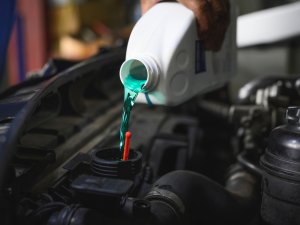Florida is a warm state. On average, we have the mildest winters in the entire Continental United States – with temperatures seldom dipping below the 40-50 degree range.
You might ask, then, why any of us in warm climates need antifreeze in our cars. Isn’t that stuff reserved for frigid climates that endure weeks of below-freezing weather every winter?
The answer is simple: no. Antifreeze is critical to cars in all climates. In this blog, we’ll explore why, and give you the info you need to take excellent care of your car this winter.
Let’s dive in.
What is Antifreeze?
Antifreeze is a liquid that, when added to your car’s cooling system, dissipates heat that builds up as the engine runs. While many people assume that antifreeze is meant to prevent your engine from freezing up in frigid weather, it does much more than that.
While antifreeze does help the engine block maintain an even operating temperature in all kinds of external weather, it also serves important lubricating, anticorrosive, and stabilizing purposes.
Here are a few benefits you should know about:
- The lubrication helps water flow in the engine, so it doesn’t corrode the engine parts.
- In frigid weather, antifreeze does indeed keep the engine cooling system from freezing.
- In hot weather, antifreeze prevents the engine from overheating.
As you can see, it’s is a critical part of a healthy engine. Without it, your car’s engine could seize up and stop working quickly.
Antifreeze vs. Coolant
The terms antifreeze and coolant are often used interchangeably, but they’re not the same thing.
Antifreeze, on the one hand, is an ethylene glycol or propylene glycol product, which must be mixed with water to create coolant. This cocktail goes into the cooling systems of all water-cooled cars on the road.
That finished product – called coolant – usually consists of 50/50 antifreeze and water, although cocktails in cold climates may contain as much as 70% antifreeze. In Florida, a 50/50 blend will provide sufficient cooling for engines, while also preventing freezing at temperatures of 30 degrees below zero or lower.
How Often Should You Change Your Coolant?
Some vehicles can go up to 100,000 miles before they require a coolant flush, while other vehicles need one every 30,000 miles and others never require new coolant.
If you’ve got questions about when to change your coolant, or which type to use in your car’s cocktail (antifreeze comes in colors like orange, pink, and green, and in a variety of different formulas meant for different vehicles), contact your local auto repair expert.
DeBroux Automotive: Complete Care for Your Car’s Cooling System
Your car’s cooling system keeps it reliable and helps you stay safe on the road. If it’s time for a coolant change or you just have a few questions about your car’s cooling system, our team is here for you.
Contact us today to learn more about our automotive repair services, or to schedule your appointment today.
